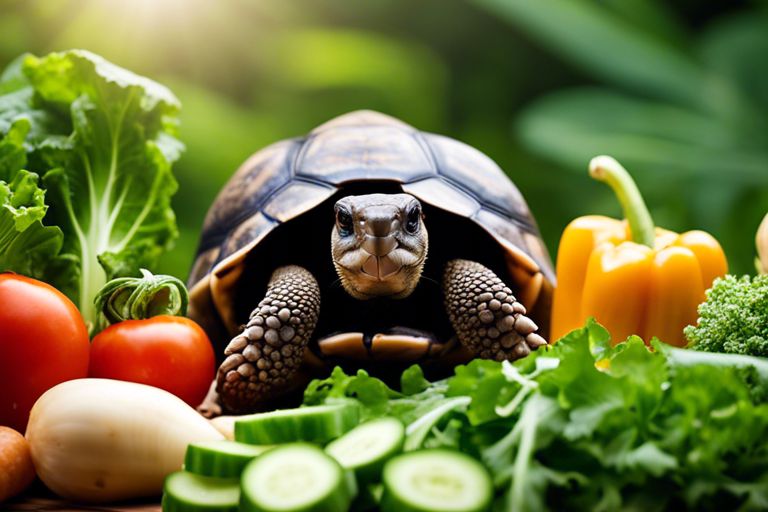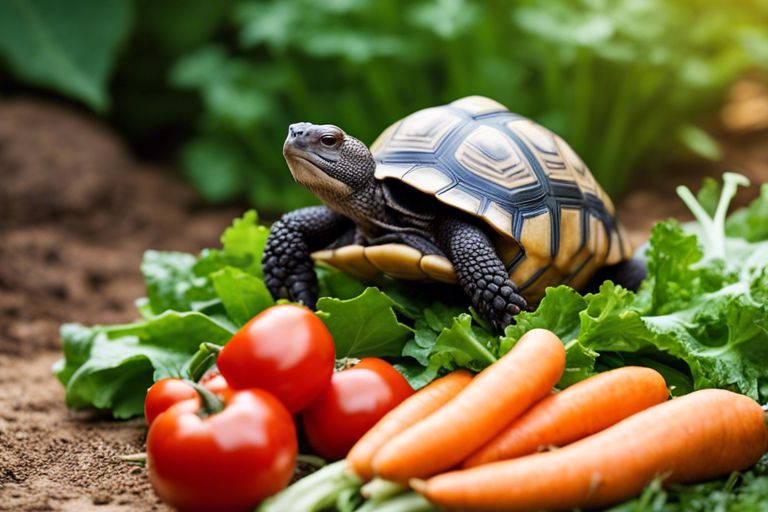There’s a lot to consider when it comes to feeding gopher turtles, as their diet directly impacts their health and well-being. These fascinating creatures are herbivores, which means they primarily eat vegetation such as grasses, fruits, and leafy greens. However, it’s crucial to provide a balanced diet to ensure they receive all the necessary nutrients for optimal health. Avoid feeding them insects or protein-rich foods, as these can lead to serious health issues in gopher turtles. Let’s explore the best foods to offer these unique reptiles to keep them thriving in captivity.
Key Takeaways:
- Variety is key: Offer a diverse diet consisting of dark leafy greens, vegetables, fruits, and occasional lean protein sources.
- Avoid toxic plants: Be cautious of feeding gopher tortoises toxic plants like rhubarb, avocado, or tomato leaves as they can be harmful.
- Proper supplementation: Ensure your gopher tortoise receives necessary nutrients by providing a calcium supplement and exposure to natural sunlight.


Natural Diet of Gopher Tortoises
Any responsible gopher tortoise owner knows the importance of providing a diet that mimics the natural diet of these fascinating reptiles. Gopher tortoises are herbivores by nature, meaning that their diet consists primarily of plant matter.
Grasses and Flowers
On their foraging expeditions, gopher tortoises will often feast on a variety of grasses and flowers. They particularly enjoy grazing on native grasses such as wiregrass and love to munch on wildflowers like yellowtop and asters. These plants not only provide essential nutrients but also help keep their beaks trimmed.
When providing a diet for your gopher tortoise, it is essential to include a variety of grasses and flowers to ensure they receive a well-rounded nutritional intake. Supplementing their diet with a mix of native grasses and vibrant flowers will help keep them healthy and happy.
Fruits and Vegetables
Grasses and flowers are not the only components of a gopher tortoise’s diet. They also enjoy indulging in a limited variety of fruits and vegetables. While these should not make up the majority of their diet, providing occasional treats like strawberries and leafy greens can be a nice addition to their meals. However, it is crucial to avoid feeding them foods high in sugars and fats, as these can lead to health issues such as obesity.
Natural fruits and vegetables can be a healthy supplement to a gopher tortoise’s diet, but they should not be the main focus. It is always best to consult with a reptile veterinarian or specialist to ensure you are providing a balanced diet that meets all of your tortoise’s nutritional needs.
Foods to Avoid
After outlining the appropriate foods for a gopher tortoise’s diet, it is equally important to be aware of foods that should be avoided to ensure their health and well-being.
Toxic Foods for Gopher Tortoises
Any gopher tortoise owner should be cautious of feeding their pet toxic plants such as oleander, azaleas, and rhododendrons. These plants contain toxins that can be harmful and even fatal to gopher tortoises if ingested. Additionally, avoid feeding your tortoise fruits with pits or seeds, as they can pose a choking hazard or cause digestive issues.
It is crucial to never feed a gopher tortoise any food that has been treated with pesticides or chemicals. These substances can be highly toxic to gopher tortoises and can have severe health consequences. Be diligent in ensuring that any food sources provided are free from harmful chemicals.
Common Dietary Misconceptions
On occasion, there are common misconceptions about what foods are suitable for gopher tortoises. One such misconception is that all leafy greens are safe for tortoises to consume. While many leafy greens are nutritious, some, such as spinach and kale, can be high in oxalates and should be fed in moderation to prevent potential health issues.
Toxic foods should always be avoided, as they can be harmful or even deadly to gopher tortoises. It is essential to research and understand the dietary needs of these reptiles to provide a balanced and safe diet for optimal health.
Feeding Practices
Now, when it comes to feeding a gopher tortoise, it is important to understand the right practices to ensure their health and well-being. Providing the correct diet is essential for their longevity and happiness in captivity.
Feeding Frequency and Portion Sizes
Portion control is crucial when feeding gopher tortoises. It is recommended to feed adult gopher tortoises every other day, while juvenile tortoises can be fed daily. Overfeeding can lead to obesity and health issues, so it is important to monitor their portion sizes. Offer a variety of fresh vegetables, fruits, and grasses to cater to their dietary needs.
It is best to feed gopher tortoises early in the morning when they are most active. Monitor their eating habits and adjust portion sizes accordingly. Remember to provide clean, fresh water at all times to keep them hydrated.
Supplements and Vitamins
With gopher tortoises, it is essential to provide calcium and vitamin supplements to ensure they are getting all the necessary nutrients. Dust their food with a calcium supplement a few times a week to prevent calcium deficiency, which can lead to shell deformities and other health issues.
Feeding a variety of leafy greens and vegetables can help provide some essential vitamins, but it is always a good idea to consult with a veterinarian specializing in reptiles to determine if additional supplements are needed for your gopher tortoise.
Health and Dietary Concerns
Obesity and Nutritional Deficiencies
For gopher turtles, obesity and nutritional deficiencies can pose serious health risks. While these creatures may have hearty appetites, it is crucial to ensure they are receiving a balanced diet. Obesity can lead to a range of health issues in gopher turtles, including respiratory problems, heart disease, and reduced mobility. On the other hand, nutritional deficiencies can weaken their immune system, affect their shell health, and impact their overall well-being.
It is essential to provide a varied diet rich in essential nutrients such as calcium, vitamins, and minerals to prevent both obesity and nutritional deficiencies. Offering a mix of leafy greens, vegetables, fruits, and commercially available turtle pellets can help meet their dietary requirements and keep them healthy.
Importance of Veterinary Care
Regular veterinary check-ups are crucial for maintaining the health of your gopher turtle. A reptile veterinarian can assess their overall well-being, provide dietary guidance, and detect any health issues early on. Obesity and nutritional deficiencies can be managed more effectively with the help of a knowledgeable vet who specializes in reptiles.
Importance of veterinary care cannot be overstated, as early intervention can make a significant difference in the longevity and quality of life of your gopher turtle. Veterinary visits also allow for necessary treatments, such as deworming or shell repairs, to be carried out promptly, ensuring your turtle remains in optimal health.
To wrap up
So, when deciding what to feed a gopher tortoise, it’s important to prioritize a diet that mimics their natural foraging habits. This includes providing a variety of leafy greens, vegetables, fruits, and grasses to ensure they receive the proper nutrients they need to stay healthy. Avoid feeding them high-protein or high-fat foods, as these can be harmful to their well-being. Remember to also provide clean, fresh water at all times and seek advice from a veterinarian or wildlife expert for the most suitable diet plan for your gopher tortoise.





Leave a Reply